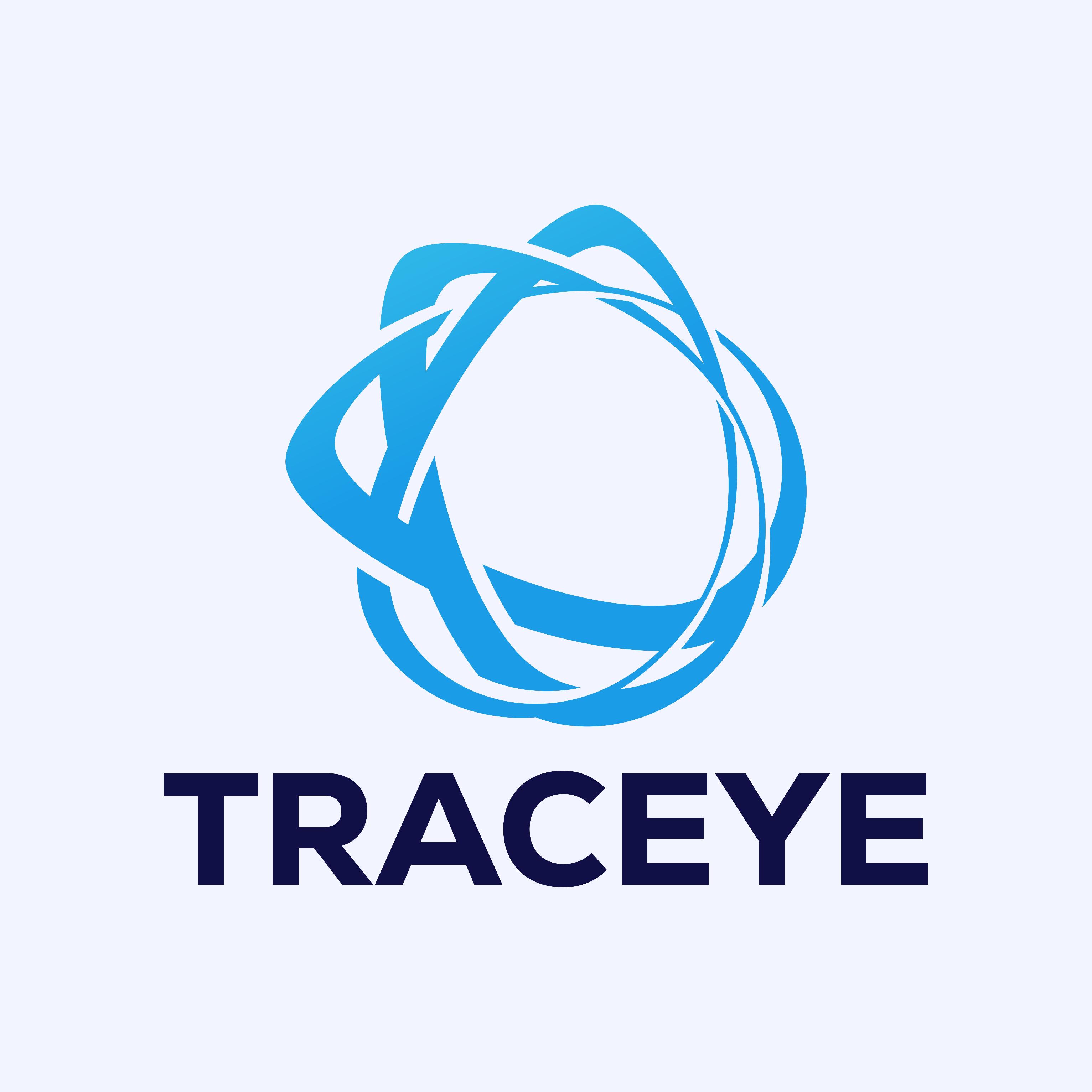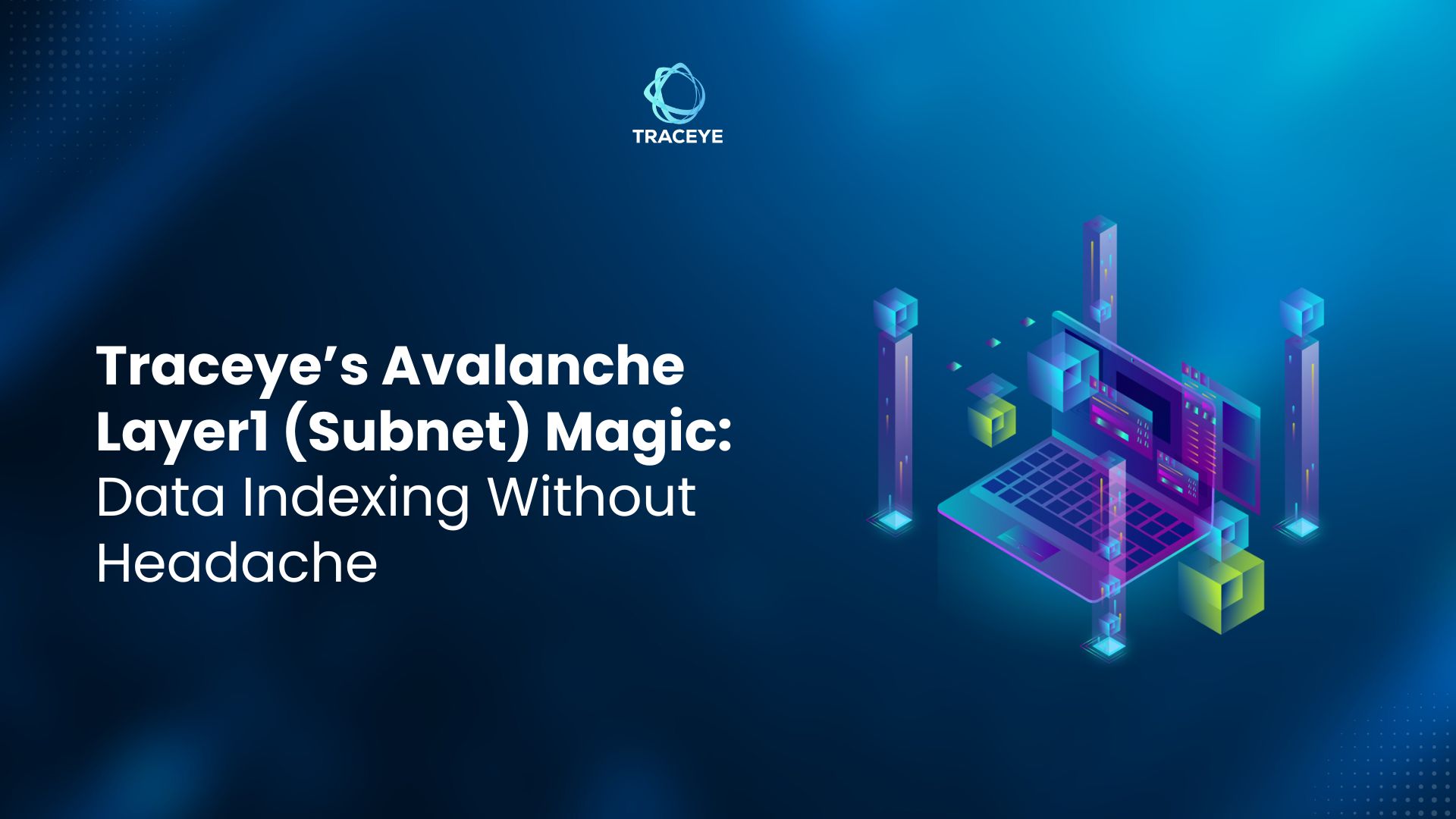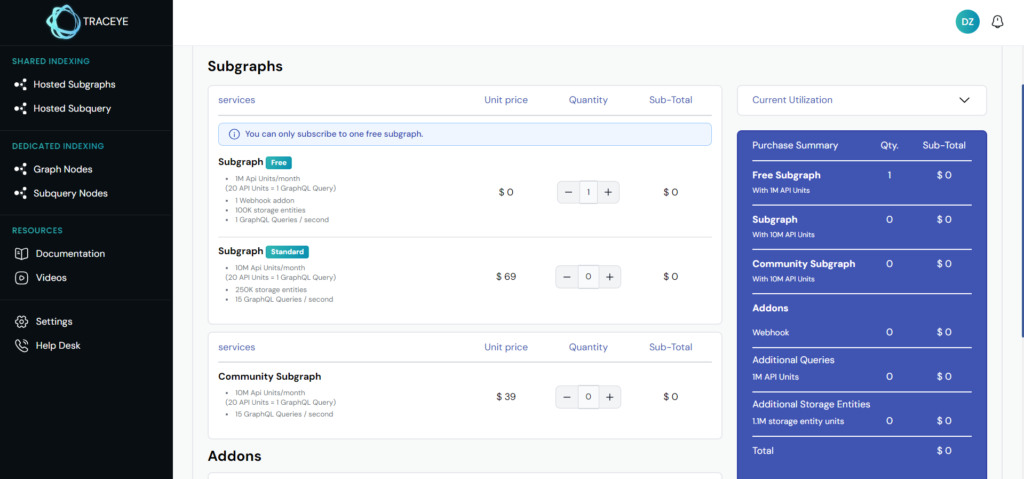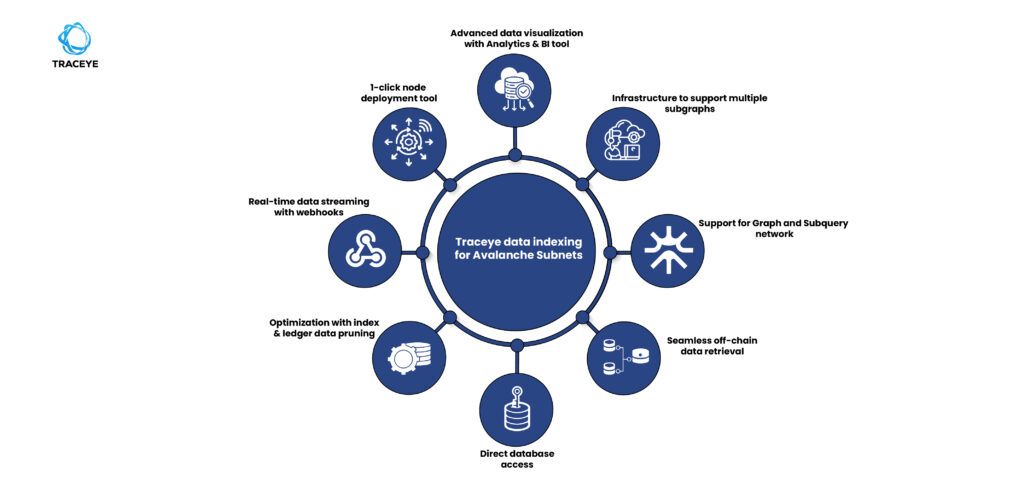Traceye’s Avalanche Layer1 (Subnet) Magic: Data Indexing Without Headache
 Traceye
Traceye
Traceye is excited to add support for Avalanche Layer1 (rebranded from Subnets) All kinds of custom Layer1 blockchains building their subnets can now use Traceye as their dedicated data indexer for low-cost and efficient indexing. With this addition, Traceye is now offering data indexing to a comprehensive list of appchains and rollup networks such as Polkadot Parachains, Cosmos SDK, Polygon CDK, OP Stack, ZKsync chains, and Arbitrum Orbit.
Let’s discuss Traceye’s data indexing offerings for Avalanche L1 (Prev. Avalanche Subnet) in detail. This will highlight the main factors that make Traceye a preferred data indexing solution for Avalanche Layer1 and all leading appchains.
A brief about Avalanche Layer1 (Prev. Subnet)?
Avalanche subnets (now Layer1) is Avalanche’s scaling solution that allows horizontal scaling for custom, application-specific blockchains building with it. Avalanche L1 includes a unique architecture integrated with a powerful consensus and multi-chain system to enable the creation of massive scalable and flexible chains where a ‘subnetwork’ consists of nodes (validators) that are accountable for reaching consensus on one or more blockchains. For such a high-performance and use case-specific Avalanche Layer1 ecosystem, a dedicated indexer is crucial to ensure unlimited queries, lightning-fast response, database optimization, and a lot more.
What types of Avalanche Layer1 networks can use Traceye data indexer?
As discussed, Avalanche Layer1 (Subnets) allows for the creation of custom-fitted scalable blockchains to enable easy scalability, decreased gas fees, higher TPS, and interoperability. These chains can use Traceye as their data indexing solution to leverage unmatched benefits like blazing-fast indexing, cost-efficient subscriptions, multiple subgraph support, 100% uptime & availability, and valuable add-on services.
Below are the main categories of subnets that can set up their dedicated data indexer on Traceye:
Private and permissioned subnets: Private and permissioned Avalanche L1s can use Traceye data indexer to index within their restricted ecosystem while concealing data privacy and adding accessibility parameters.
Public subnets: Public or permissionless Avalanche L1s have the choice to use Traceye for protocol-specific data indexing, or they can launch a set of custom subgraphs to offer them to community usage.
How Traceye offers seamless Avalanche Layer1 Indexing?
- Rapid node launch with 1-click deployment tool:
Traceye breaks down the complex process of setting up a data indexer, customizing it, and launching it into a simple low-code process. It offers a one-click deployment tool that anyone, even users with basic web3 data indexing knowledge, can launch their indexer node and include necessary add-ons while also setting up a 24/7 monitoring system to track and ensure the performance & availability of the node. Let’s quickly see how Traceye’s low-code tool works:
- Login or sign up for Traceye. From the dashboard, select ‘Graph Nodes’ or ‘Subquery Nodes’.

2. Get a subscription for the node if you haven’t already. Select your desired service and enable necessary add-ons. Next step is indexer node deployment.
3. Let’s assume that you’ve subscribed for Graph node. Now, click on ‘Deploy’ and complete all the steps; add basic details, choose addons, and enter your blockchain network by providing the network name and RPC Endpoint of your Avalanche Layer1 (Subnet).
4. Upon submission, your node will be launched successfully and ready for data indexing in a while. Note that, you can opt for addon services even when your node is launched and functioning properly.
- Real-time data streaming with webhooks:
Avalanche Layer1 (earlier Subnets) are custom blockchains that require diligent access to real-time data, apart from indexed data. However, retrieving live data through indexers can be a complex and resource-intensive method. To provide a solution, Traceye offers webhooks features that subnets can use to fetch real-time data seamlessly to maintain high responsiveness in the network. This webhook feature is available as add-ons on Traceye that you need to enable while subscribing for the nodes.
- Optimization with index & ledger data pruning:
Storage and query optimization is important to ensure streamlined access to data on your Avalanche Layer1 network. Traceye understands this well and therefore it offers ‘Index and Ledger Data Pruning’ feature. Applications running on subnets can use this feature to retain data for desired block count and prune rest of the data automatically on each event. For example, you can retain data for 10,000 blocks and prune the rest. Speaking about the differences, index data pruning is designed to prune data from network’s metadata directly while ledger data pruning works to prune data from databases.
- Direct database access:
Traceye adds an additional layer of abstraction to the complicated data indexing & query process with its elastic and custom search offerings. This allows Avalanche Layer1 to fetch necessary data from the indexed databases without running GraphQL-based queries. Note that direct database access is designed to offer ease, and hence speed & performance here can be compromised a bit. As a solution, Traceye allows combining GraphQL queries and direct DB access features. To enable this, you need to do essential configurations in the network and add subgraph schema containing custom entities.
- Seamless off-chain data access:
Off-chain data access is becoming an integral aspect of data indexing for Avalanche L1s, just like any other appchain, L1/L2, and rollup networks. Hence, Traceye offers ‘Custom Entities’ feature that allow networks to retrieve off-chain data easily from the indexer node without any complex customization & configuration. For example, popular gaming & virtual world Decentraland can use custom entities feature to access off-chain data from web2 platforms for a variety of purposes like user identity & verification, asset integration, cross-promotion, currency/value conversion, etc.
- Support for The Graph and Subquery network:
Traceye is designed to serve as a full-featured Web3 data indexing solution and hence it offers support for popular indexing protocols like The Graph protocol and Subquery network. Avalanche Layer1 networks can launch their data indexer node for these protocols in a few clicks using Traceye’s low-code tool that we highlighted in the first point.
- Multiple subgraphs launch:
Traceye’s dedicated indexer node can offer infrastructure to support multiple subgraphs designed for use case-specific purposes. Like, your node for Avalanche Layer1 (prev. Subnets)indexing can offer infrastructure for gaming subgraph, asset tokenization, DeFi, communication, media, and more. Traceye ensures top-notch performance for all the subgraphs despite the amount of queries it handles or the data it retrieves.
- Advanced data visualization with Analytics & BI tool :
Traceye’s Analytics & BI tool transforms on-chain raw data into actionable insights using graphs, tables, and dynamic charts. Despite the types of your Avalanche Layer1, be it a general-purpose Layer1 or DeFi, gaming, or tokenization-based, you can use an analytics & BI tool to create custom data reports and explore them over an interactive dashboard. As required, you can integrate the statistics and reports into a preferred interface to enjoy hyper-immersive data navigation.
- Indexer-node-as-a-service:
Traceye’s service doesn’t end with launch and customization of your indexer node. It also takes accountability to maintain performance of your nodes and subgraphs running on it. As a default component, Traceye offers 24/7 monitoring setup to keep track of your indexer node, check issues via real-time alerts and ensure immediate solution. Some of the critical parameters for monitoring are CPU usage, memory running out, RAM utilization, cloud usage, and more.

Launch your Avalanche Layer1 (Subnet) indexer on Traceye
Avalanche Layer1 (subnet) is a huge ecosystem with 133+ active Subnets and a vast backing of around 1,434 validators. Now after subnet’s rebranding to Avalanche Layer1 is offering enhanced customization and scaling features, encouraging more projects to build their Layer1 with Avalanche. If you are planning to launch your Avalanche Layer1 or migrate existing solution, Traceye can be your ideal indexing solution. The features we discussed are just a snapshot of Traceye’s offerings. For more details, contact our experts or send us your queries via mail.
Subscribe to my newsletter
Read articles from Traceye directly inside your inbox. Subscribe to the newsletter, and don't miss out.
Written by

Traceye
Traceye
Traceye is an Enterprise-grade data indexing infrastructure platform to build and deploy subgraphs with best-in-class performance, security and scalability.